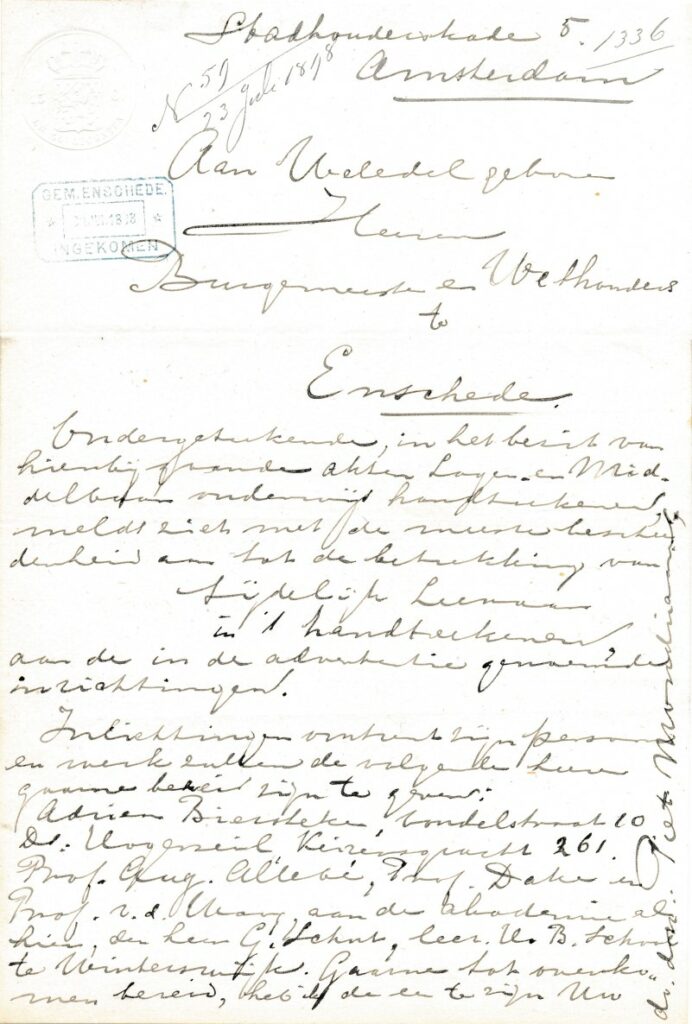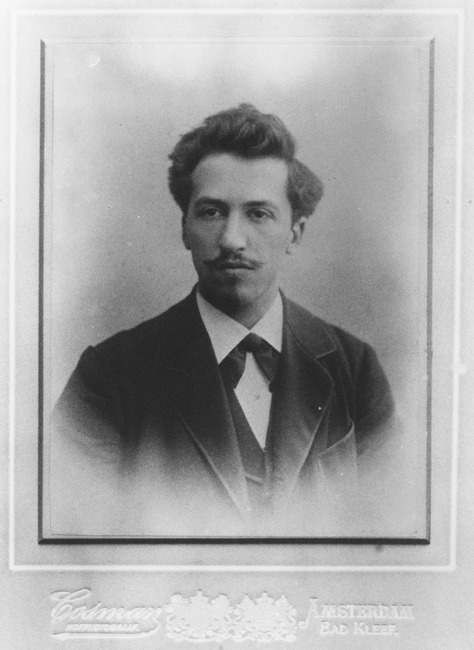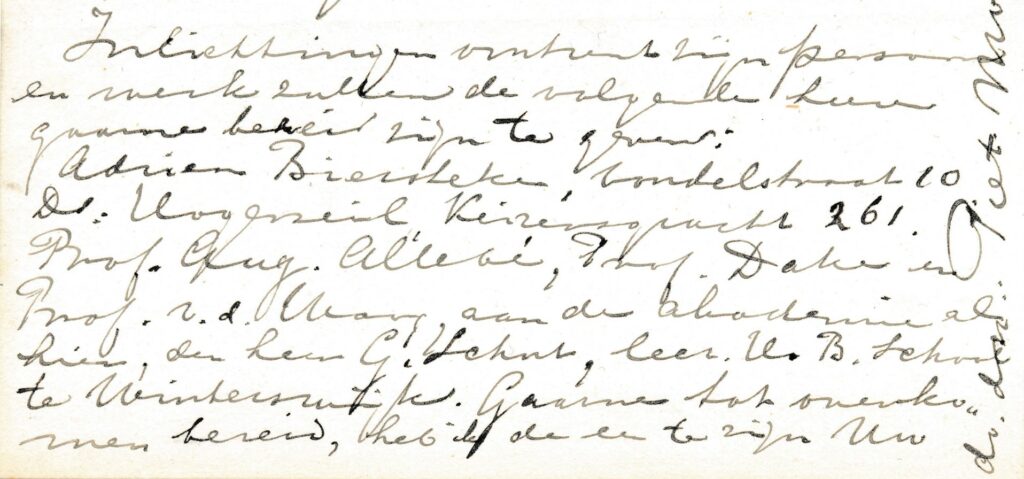by Jitske Lamain

Correspondence from the period before the turn of the century has been handed down only sporadically. Due to limited information about this period, the known letters from this time evoke many questions. One of the letters that has been handed down, concerns Mondrian’s request of a certificate of conduct for a job application in Enschede in 1898. Until now, however, little is known about the job application itself. Thanks to the discovery of Mondrian’s letter of application in the municipal archive in Enschede, some of these queries can be solved. The references mentioned in the letter of application provide new insight into Mondrian’s network around that time and show that his network supported him not only financially but also professionally.
After a stay with his family in Winterswijk in the summer of 1898, Mondrian requests the mayor of the municipality of Amsterdam for a ‘Certificate of Good Conduct’. He needs the certificate for an application ‘for a municipal job’ in Enschede. Based on this letter and the submitted certificate of conduct, it has been assumed that Mondrian applied for a job as a drawing teacher in Enschede in 1898 (Marty Bax, Piet Mondriaan 1892-1912: the Amsterdam years (1994)). Mondrian’s application letter was recently discovered, thereby confirming the earlier hypothesis.
In late July 1898, a letter from Mondrian, addressed to the ‘Well-born Gentlemen Mayor and Councilors of Enschede’, arrived at the municipality of Enschede. The letter was most likely written one day prior to its receipt on 30 July 1898, that is, on 29 July 1898. By means of this letter, Mondrian applied with ‘the utmost modesty for the position of temporary teacher of drawing at the institutions mentioned in the advertisement’. The letter is probably written in response to the public announcement in the local newspaper Tubantia of 21 July 1898, in which it was announced that two positions as a temporary teacher at the Nederlandse School voor Nijverheid en Handel and the Ambachts-avondschool (Dutch School of Industry and Commerce and the evening Craft School) in Enschede had become vacant. The assumption was that Mondrian applied for one or two positions in Enschede in response to this announcement, but with the discovery of this letter of application it can be confirmed that Mondrian applied for both temporary positions.

In the period after the completion of his education at the Rijksakademie van Beeldende Kunsten (National Academy of Art) in 1897, Mondrian tried to make ends meet by teaching privately, painting commissioned copies and portraits, and selling his artworks, at, for instance, the artist association Kunstliefde, Arti et Amicitae and St. Lucas. His financial situation can be considered as a possible motivation for his application. The vacancies at the Nederlandse School voor Nijverheid en Handel and the Ambachts-avondschool were for one year, a foreseeable period, during which Mondrian could save enough money to then focus again on his career as an artist.
In the letter of application, Mondrian mentions several references, including three professors at the Rijksakademie and two acquaintances for which he made commissioned work: Adriaan Biersteker (1862-1934) and Hendrikus Vredenrijk Hogerzeil (1839-1907). These references shed new light on Mondrian’s network during this period. The last two names are indicative of how Mondrian received not only financial but also professional support from acquaintances from Protestant circles and his father’s network. When Mondrian first moved to Amsterdam, he came to live above the Hövekers Boekhandel (book shop) of Johan Adam Wormser (1845-1916) at Kalverstraat 154 (Welsh/Joosten 1998, I, p. 116). Through Wormser, it is believed, Mondrian came into contact with the dentist Adriaan Biersteker (Bax 1994, p. 26). In 1894, he painted a portrait of Biersteker’s daughter Gretchen, and a few years later of his son Noël (Welsh/Joosten 1998, I, p. 163-164). The inscription on the latter work is: ‘To his friend / Adr. Biersteker / from Piet Mondriaan’. It has been suggested that the paintings were possibly made in exchange for dentist treatments (Bax 1994, p. 26).

His relation with the Dutch reformed minister Hogerzeil was similar. Supposedly in exchange for meals, Mondrian gave drawing lessons to his daughters (Bax 1994, p. 26). He also produced a portrait of Hogerzeil, that, within the Hogerzeil family, is said to have been made posthumously, after a photograph (Welsh/Joosten 1998, p. 307).
As references, Mondrian lists not only his professors August Allebé (1838-1927), Carel Lodewijk Dake (1847-1918 and Nicolaas van der Waay (1855-1936) at the Rijksakademie, with whom he apparently had established a good relationship, but he also provides a reference from Winterswijk: ‘Mr. G. Schut, teacher H. B. School at Winterswijk’. From 1880 to 1901, Mondrian and his family lived in the Zonnebrink, a teacher’s home adjacent to the Christian primary school where Mondrian senior was installed as a head teacher in 1880 (Scholtz 1994, p. 88). The house is located opposite the Rijks Hoogere Burgerschool (state secondary school) where Gerhard Wilhelm Schut (1848-1932) was employed as a drawing teacher (Scholtz 2013, p. 88). Although Mondrian did not attend school there, Schut lent him plaster models of the school that he could copy at home (Scholtz 2013, p. 88). Earlier, Schut was the drawing instructor of the Dutch artist Jan Toorop (1858-1928), who lived in Winterswijk in 1874-1875. Toorop is regarded as one of the fathers of modern Dutch painting. He and Mondrian later became good friends and spent time at the Dutch seaside town Domburg, where Toorop lived. It was here that Mondrian’s style underwent a radical change, adapting a rigorously modern palette.
Besides Mondrian, eighteen other candidates applied for this vacancy. The reason Mondrian was not selected remains unclear, but perhaps it was due to a lack of experience compared to (some of) the other candidates. Nevertheless, this letter of application provides new insight into Mondrian’s network during this period. In the period that followed, numerous opportunities awaited Mondrian, such as executing a commissioned ceiling painting in a private residence in Amsterdam. The person appointed for the vacant jobs, Hendrik Jan Rodenburg, remained anonymous in Dutch art history, while Mondrian went on to become one of the pioneers of twentieth century abstraction.
Jitske Lamain studies Art History at the University of Utrecht and was an intern with The Mondrian Papers between February 2023 and June 2023.